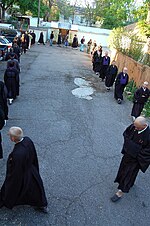Walking meditation

Walking meditation, sometimes known as kinhin (Chinese: 經行; Pinyin: jīngxíng; Romaji: kinhin or kyōgyō; Korean: gyeonghyaeng; Vietnamese: kinh hành), is a practice within several forms of Buddhism that involve movement and periods of walking between long periods of sitting meditation.[1] In different forms, the practice is common in various traditions of both Theravada and in Mahayana Buddhism.
Practice
[edit]Practitioners typically walk clockwise around a room while holding their hands in a gesture with one hand closed in a fist while the other hand grasps or covers the fist (Chinese: 叉手; pinyin: chā shǒu; rōmaji: shashu).[2] During walking meditation each step is taken after each full breath.[3] The pace of walking meditation can be either slow (several steady steps per each breath) or brisk, almost to the point of jogging.[2]
Etymology
[edit]The term kinhin consists of the Chinese words 經, meaning "to go through (like the thread in a loom)", with "sutra" as a secondary meaning, and 行, meaning "walk". Taken literally, the phrase means "to walk straight back and forth."
See also
[edit]References
[edit]- ^ Maezumi & Glassman 2002, pp. 48–9.
- ^ a b Aitken 1999, pp. 35–6.
- ^ "Kinhin". Empty Bowl Zendo. Retrieved April 1, 2015.
Sources
[edit]- Smith, L. (2023). 28 Meditation Statistics: How Many People Meditate? The Good Body. https://www.thegoodbody.com/meditation-statistics/
- Team, M. (2022). How Many People Meditate? Mindworks Meditation. https://mindworks.org/blog/how-many-people-meditate/
- Wise, J. (2023). Meditation Statistics 2023: Popularity, Industry & Market Size - EarthWeb. EarthWeb. https://earthweb.com/meditation-statistics/#:~:text=Meditation%20Statistics%202023-,Approximately%20200%20to%20500%20million%20people%20across%20the%20globe%20partake,reduce%20school%20suspensions%20by%2045%25.
Bibliography
[edit]- Aitken, Robert (1999). Taking the Path of Zen. North Point Press. pp. 35–36. ISBN 0-86547-080-4.
- Maezumi, Hakuyu Taizan; Glassman, Bernie (2002). On Zen Practice: Body, Breath, Mind. Wisdom Publications. pp. 48–49. ISBN 086171315X.
- Jin, Putai. "Efficacy of Tai Chi, Brisk Walking, Meditation, and Reading In Reducing Mental and Emotional Stress". doi.org/10.1016/0022-3999(92)90072-A
- Prakhinkit, Susaree "Effects of Buddhist Walking Meditation on glycemic control and vascular functions in patients with Type-2 Diabetes." Journal of Alternative and Complementary Medicine doi.org/10.1016/j.ctim.2016.03.009
- Prakhinkit, Susaree "Effects of Buddhism walking meditation on depression, functional fitness, and endothelium-dependent vasodilation in depressed elderly." Journal of Alternative and Complementary Medicine, vol. 20, no. 5, 2014, doi.org/10.1089/acm.2013.0205
- Chatutain, Apsornsawan “Walking Meditation Promotes Ankle Proprioception and Balance Performance among Elderly Women.” doi.org/10.1016/j.jbmt.2018.09.152
- Smith, Alison. “Walking Meditation: Being Present and Being Pilgrim on the Camino De Santiago.” Religions, vol. 9, no. 3, 2018, p. 82., doi:10.3390/rel9030082
